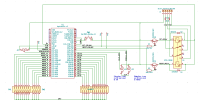GONOGO-LP (Low Power)

Better than GONOGO ? Is it possible ? "Impossible n'est pas français" said Napoleon ! (Impossible is not French). GONOGO-LP is the solution. Like GONOGO but with a power consumption lower than 1 mA. And also, new ideas to divert the gonogo board from its original use. So ... let's gonogo ! Oh ! Sorry ... let's go
GONOGO is a programmer that periodically activates a two-contact relay (2RT) according to the following cycle: a work phase (GO) followed by a rest phase (NOGO) whose duration can be programmed according to two time resolutions:
- From 1 second to 1 hour, 8 minutes and 15 sec with a resolution of 1 second,
- From 1 minute to 2 days, 20 hours and 15 minutes with 1 minute resolution.
Gonogo is implemented in VHDL on a LAttice FPGA available on the Upduino3.1 board. This board is itself implemented on a printed circuit with all the additional components required to perform the GONOGO function.
Gonogo Low Power is a variant of Gonogo with a power consumption lower to 1 mA (compared to 20 mA in the original Gonogo version.)
The article describes the implementation of Gonogo,, VHDL code but also the use of the Radiant development tool from Lattice.
VHDL code and Kicad files are provided for free on simple demand to the author.
- From 1 second to 1 hour, 8 minutes and 15 sec with a resolution of 1 second,
- From 1 minute to 2 days, 20 hours and 15 minutes with 1 minute resolution.
Gonogo is implemented in VHDL on a LAttice FPGA available on the Upduino3.1 board. This board is itself implemented on a printed circuit with all the additional components required to perform the GONOGO function.
Gonogo Low Power is a variant of Gonogo with a power consumption lower to 1 mA (compared to 20 mA in the original Gonogo version.)
The article describes the implementation of Gonogo,, VHDL code but also the use of the Radiant development tool from Lattice.
VHDL code and Kicad files are provided for free on simple demand to the author.




Discussie (0 opmerking(en))